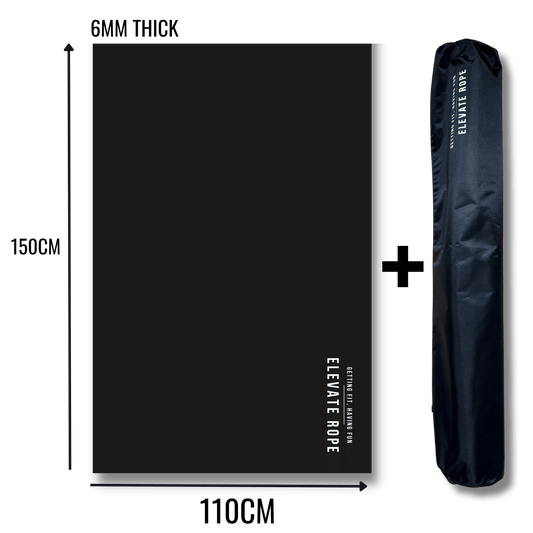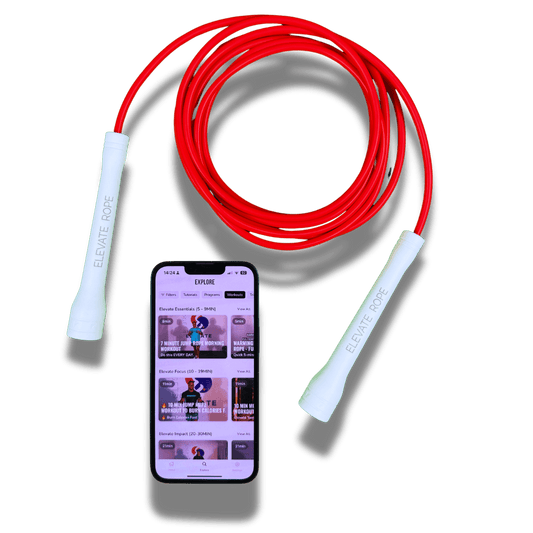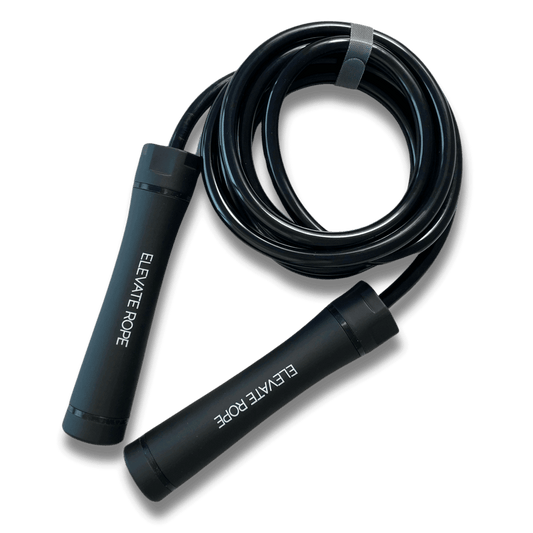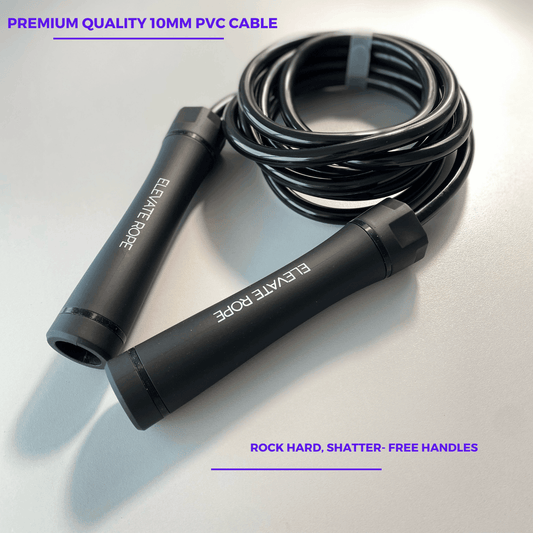Walk into any boxing gym in New York, a Muay Thai camp in Thailand, or an MMA facility in Las Vegas and you’ll hear the same sound: the clean snap of rope against the floor. It’s one of the oldest tools in combat sports, and yet it remains one of the most effective.
Modern fighters use jump rope not because it's traditional, but because it’s uniquely powerful. It improves the most important skills in striking sports — footwork, timing, rhythm, balance, agility, coordination, and high-intensity conditioning.
This is the complete, modern training guide for fighters who want to move better, react faster, and build real fight endurance through jump rope for boxers.

Why Fighters Use Elevate Jump Rope
Jump rope training is woven into the culture of combat sports because it develops qualities fighters absolutely need. Unlike steady-state cardio, rope work directly mimics the rhythm, explosiveness, and footwork demands of a fight.
Jumping rope conditions the anaerobic system — the one used during bursts of striking, scrambles, and explosive entries. It sharpens timing and improves the ability to change pace quickly, something every striker must master.
It also forces fighters to stay light on their feet. You cannot jump rope effectively if you land heavy or slow. The rope teaches reactivity, quick adjustments, smooth transitions, and constant movement — the exact attributes needed inside the ring or cage.
A 2023 study in the Journal of Sports Science found that jump rope for boxers significantly improves lower-limb reactive strength and neuromuscular coordination faster than running or cycling. For fighters, that means better stability, better balance, and faster movement.
And perhaps most importantly, rope work builds mental flow. Many athletes report that once the rhythm locks in, they enter a focused, calm state — something invaluable in high-pressure combat environments
Footwork Fundamentals in Boxing & MMA
Before jump rope for boxers can elevate your movement, it’s important to understand the fundamentals of proper footwork.
The fighting stance is the foundation of striking. A good stance allows you to be mobile without losing balance. You should be able to move in any direction quickly while still being stable enough to strike with power.
Step-and-slide movement is the most essential footwork principle. You lead with the foot moving toward the direction you want to go, and the other foot follows. This keeps your stance width intact so you never cross your feet or become unbalanced.
Pivots and angle changes allow fighters to slip attacks and create new openings without wasting energy. A good pivot can help you avoid punches, line up counters, and break your opponent’s stance — all with minimal movement.
Finally, rhythm and cadence turn footwork into a natural flow instead of a robotic pattern. Great fighters move with controlled rhythm. Jump rope for boxers helps develop this instinctive sense of pace.
Beginner Jump Rope Progress Timeline
Beginner Jump Rope Progress Timeline for Fighters
Week 1–2: Learn basic bounce, boxer step, and practice staying light on your feet.
Week 3–4: Add lateral hops, the running step, and aim for 2–3 minutes unbroken.
Week 5–6: Introduce tempo changes, pivot hops, and short explosive intervals.
Week 7–8: Start using the heavy rope, mix advanced footwork patterns, and extend round duration.
Addition 2 — Weekly Fighter Jump Rope Schedule
A Sample Weekly Jump Rope Schedule for Fighters
Monday: Footwork training with speed rope (15 minutes).
Tuesday: Conditioning intervals and sprint sets (10–12 minutes).
Wednesday: Shadow skipping and rhythm practice (8 minutes).
Thursday: Heavy rope power and shoulder endurance (10 minutes).
Friday: Mixed footwork flow + freestyle (20 minutes).
Saturday: Long endurance round for late-fight stamina (5–7 minutes).
Sunday: Active recovery or light rhythm bounce (3–5 minutes).
Addition 3 — What Improves in 30 Days
What Fighters Can Expect After 30 Days of Jump Rope Training
- Faster, lighter footwork with less effort
- Better rhythm during padwork and sparring
- Sharper defensive reactions and cleaner pivots
- Noticeable conditioning improvements in rounds
- More fluid entries and exits when striking
- Improved breathing control during combinations
Addition 4 — Quick Footwork Problem Fixes
Quick Fixes for Common Footwork Problems
If your feet feel heavy → reduce your bounce height.
If you lose balance often → widen your stance slightly.
If you gas out early → use the boxer step to regulate pace.
If timing feels off → switch to a beaded rope for clearer feedback.
If pivots feel slow → practice 30-second pivot hop bursts between rounds.
How Jump Rope Improves Fighter Footwork
Jump rope for boxers improves footwork in ways few other tools can.
It teaches you to stay light on your feet. Landing softly on the balls of your feet becomes second nature. Heavy-footed fighters quickly learn how to become more reactive and agile.
Foot turnover increases dramatically. Each jump forces a quicker movement pattern, building the muscle elasticity needed for fast entries, exits, and angles.
Jump rope for boxers also reinforces weight transfer — a fundamental component of striking power, defensive movement, and kick setups. The constant left-to-right and forward-back shifting builds the exact mechanics needed for real fight scenarios.
Distance control is another hidden benefit. Drills like lateral hops and forward-back patterns directly mirror striking footwork and help fighters get comfortable moving around opponents.
Finally, jump rope for boxers connects upper-body actions with lower-body timing. Many beginners struggle to coordinate their hands and feet. Rope work naturally corrects this.

Best Types of Jump Rope for boxers
Different ropes serve different purposes in combat sports training. Fighters often benefit from using more than one style.
The speed rope is a must-have for combat athletes. Its lightweight design allows for fast rotations, quick footwork, and high-intensity conditioning. It’s ideal for warm-ups and explosive drills.
The beaded rope is perfect for learning rhythm and timing. Its audible feedback helps beginners develop consistent cadence and cleaner technique. It’s also extremely useful for fighters who need to build foundational footwork.
Heavy ropes add a strength and conditioning element. They develop shoulder endurance, arm stamina, and upper-body power — all critical for MMA athletes, especially during fight camp.
Long-handle freestyle ropes offer advanced movement possibilities. Fighters who focus on dynamic footwork can use them to build creativity, coordination, and complex movement patterns.
Essential Jump Rope Drills for Boxers & MMA Fighters
Certain drills translate directly from rope work into fighting skill.
The boxer step is the most fundamental. You shift weight from one foot to the other in a smooth rhythm, mimicking actual fight footwork.
The running step increases endurance and foot speed. It teaches reactive movement and builds stamina for long striking rounds.
Lateral hops help with side movement, evasion, and angle changes. They’re essential for fighters who want to move off-center quickly.
Forward-back steps mirror real fight movement. Learning to enter and exit range naturally is one of the biggest advantages jump rope for boxers offers.
Pivot hops train rotational balance and timing, helping fighters create angles without breaking rhythm.
Conditioning Workouts for Combat Sports
Jump rope conditioning is one of the closest forms of training to actual fight pace. It seamlessly blends steady rhythm with explosive bursts.
A classic three-minute fighter round alternates between steady pacing, short sprints, lateral movements, and minimal rest. This perfectly mimics the unpredictability of striking exchanges.
High-intensity interval training with the rope builds elite-level stamina. Short, fast bursts followed by brief rest periods train both anaerobic and aerobic systems.
Endurance rounds — jumping for several minutes without stopping — build mental toughness and late-round durability.
Building a Complete Fighter Jump Rope Routine
A strong fighter routine combines footwork, conditioning, and rhythm training.
Beginners might start with a simple 10-minute sequence that includes basic bounce, boxer step, lateral hops, and a short freestyle finish.
Intermediate fighters can introduce double-unders, tempo shifts, and pivot drills to increase complexity and challenge.
Advanced fighters often train with heavy ropes, explosive intervals, and extended rounds that simulate real fight pacing.
The goal is consistency. Ten to twenty minutes a day can dramatically transform a fighter’s movement and conditioning.
Mistakes Fighters Make (and How to Fix Them)
Many athletes jump too high when starting. Staying low — barely leaving the floor — improves efficiency and speed.
Landing heavily is another common mistake. Fighters should aim to land softly on the balls of their feet to stay reactive.
Using a rope that’s too long or too short affects timing. A proper fit has the handles reach the armpits when the rope is stepped on.
Tension in the shoulders can kill rhythm. Keeping the arms relaxed and turning the rope with the wrists is key.
Finally, many beginners don’t control rhythm. Beaded ropes can help create a consistent tempo and build smoother timing.
Fight Camp Jump Rope Programming
Rope training looks different at various stages of fight camp.
Eight weeks out is the engine phase. Fighters focus on volume, endurance, and longer rounds.
Four weeks out is where sharpness takes priority. Speed intervals, heavy rope conditioning, and tempo drills dominate training.
Fight week is all about staying light and loose. Rope work here is rhythmic, calm, and designed to maintain timing without accumulating fatigue.
Recommended Elevate Rope Setups for Fighters
The Elevate Speed Rope is the ideal tool for improving fast footwork and high-intensity conditioning. It’s lightweight, durable, and designed for explosive movement.
The Beaded Rope is perfect for developing rhythm, timing, and clean technique — especially for beginners learning footwork fundamentals.
The Heavy Rope helps build upper-body stamina and striking endurance, making it a powerful tool during fight camp.
For fighters who want a complete, versatile setup, the Ascent Max bundle offers multiple rope types for every training goal.
Final Thoughts: Movement Wins Fights
Footwork, timing, explosiveness, endurance, balance, and rhythm — these are the qualities that define elite fighters. And jump rope builds them all.
If you want to move like a boxer, strike like an MMA athlete, and build the conditioning of a champion, start with a rope. Small daily sessions compound into real skill.
Your movement begins at your feet.
And your feet begin with the rope.














